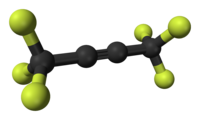Hexafluoro-2-butyne
 |
|
 |
|
| Names | |
|---|---|
|
IUPAC name
1,1,1,4,4,4-Hexafluoro-2-butyne
|
|
| Other names
HFB
|
|
| Identifiers | |
| 692-50-2 | |
| 3D model (Jmol) | Interactive image |
| ChemSpider | 62855 |
| ECHA InfoCard | 100.010.667 |
| PubChem | 69654 |
| RTECS number | ES0702500 |
|
|
|
|
| Properties | |
| C4F6 | |
| Molar mass | 162.03 g/mol |
| Appearance | Colorless gas |
| Density | 1.602 g/cm3 |
| Melting point | −117 °C (−179 °F; 156 K) |
| Boiling point | −25 °C (−13 °F; 248 K) |
| Insoluble | |
| Structure | |
| 0 D | |
| Hazards | |
| Main hazards | Toxic gas |
| R-phrases | R12 R23 |
| S-phrases | S16 S33 S45 |
| Related compounds | |
|
Related compounds
|
Dimethyl acetylenedicarboxylate Hexachlorobutadiene Acetylene |
|
Except where otherwise noted, data are given for materials in their standard state (at 25 °C [77 °F], 100 kPa).
|
|
|
|
|
| Infobox references | |
Hexafluoro-2-butyne is the fluorocarbon with the formula CF3C≡CCF3. HFB, as it is known also, is a particularly electrophilic acetylene, hence a potent dienophile for Diels–Alder reactions.
It is prepared by the action of sulfur tetrafluoride on acetylenedicarboxylic acid and the reaction of KF with hexachlorobutadiene.
...
Wikipedia
